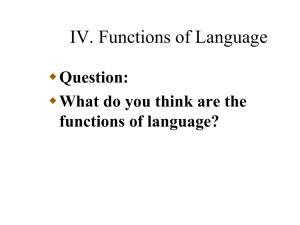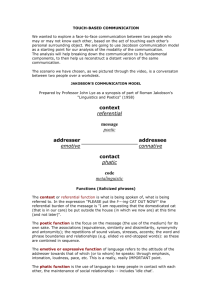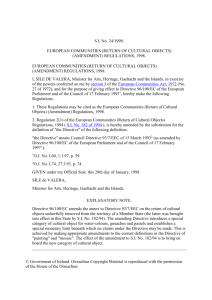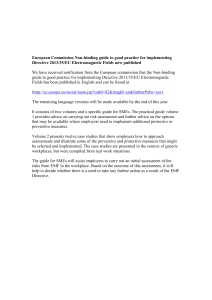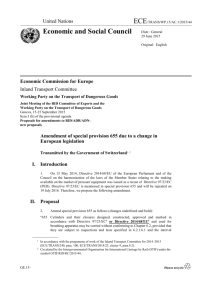lesson 1- Language function
advertisement
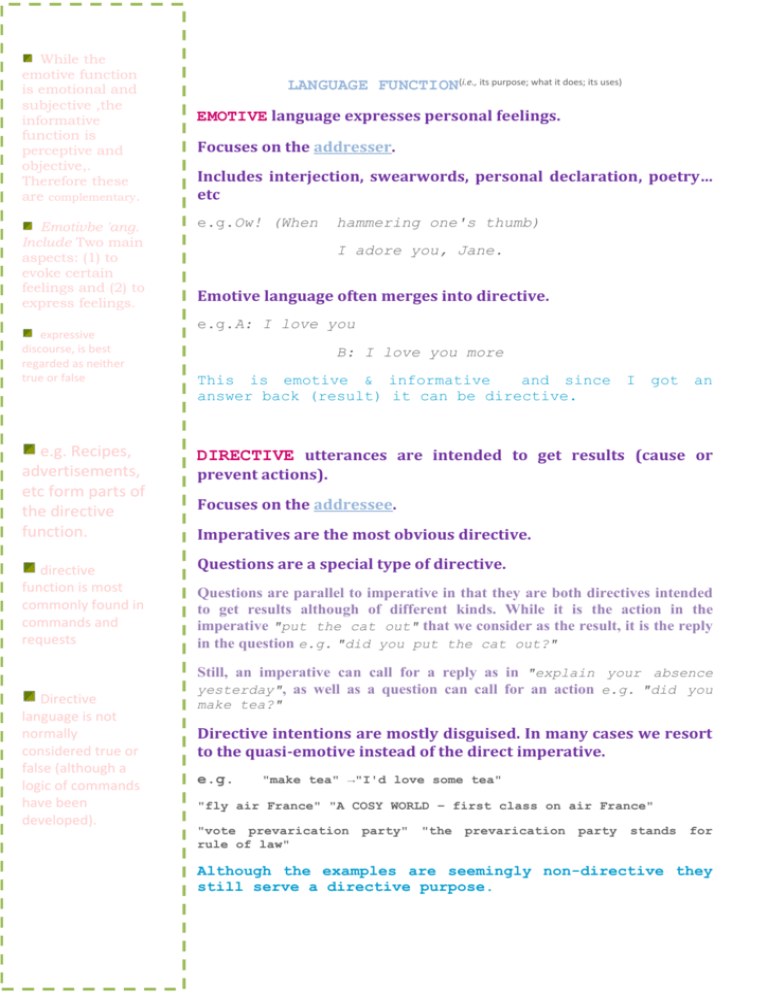
While the
emotive function
is emotional and
subjective ,the
informative
function is
perceptive and
objective,.
Therefore these
are complementary.
Emotivbe 'ang.
Include Two main
aspects: (1) to
evoke certain
feelings and (2) to
express feelings.
expressive
discourse, is best
regarded as neither
true or false
e.g. Recipes,
advertisements,
etc form parts of
the directive
function.
directive
function is most
commonly found in
commands and
requests
Directive
language is not
normally
considered true or
false (although a
logic of commands
have been
developed).
LANGUAGE FUNCTION(i.e., its purpose; what it does; its uses)
EMOTIVE language expresses personal feelings.
Focuses on the addresser.
Includes interjection, swearwords, personal declaration, poetry…
etc
e.g.Ow! (When
hammering one's thumb)
I adore you, Jane.
Emotive language often merges into directive.
e.g.A: I love you
B: I love you more
This is emotive & informative
and since I got an
answer back (result) it can be directive.
DIRECTIVE utterances are intended to get results (cause or
prevent actions).
Focuses on the addressee.
Imperatives are the most obvious directive.
Questions are a special type of directive.
Questions are parallel to imperative in that they are both directives intended
to get results although of different kinds. While it is the action in the
imperative "put the cat out" that we consider as the result, it is the reply
in the question e.g. "did you put the cat out?"
Still, an imperative can call for a reply as in "explain your absence
yesterday", as well as a question can call for an action e.g. "did you
make tea?"
Directive intentions are mostly disguised. In many cases we resort
to the quasi-emotive instead of the direct imperative.
e.g.
"make tea" →"I'd love some tea"
"fly air France" "A COSY WORLD – first class on air France"
"vote prevarication
rule of law"
party"
"the
prevarication
party
stands
for
Although the examples are seemingly non-directive they
still serve a directive purpose.
INFORMATIVE LANGUAGE uses words to indicate things or facts
Informative
language is
essentially, the
communication of
information
function can be tested for truth.
e.g. water boils at 100̊ Centigrade.
It focuses on the context.
They are typically referential.
These sentences
have a truth value;
hence, they are
important for logic
The referent of a word or a phrase is what it refers to in the
context.
e.g. "put that cat out"
when you notice a cat in your room
the referent of cat in this context is that particular
cat.
Aside from being directive, this statement is
referential.
also
It is unusual to find an utterance with no referential content at all.
Referential function is often found in the language of natural or
physical science textbooks especially in the least abstract level.
Which functions
of
language
are
activated
in
the
following text?
"This text you gave
me to correct is a
bunch
of
rubbish!
Listen to this, you've
got several verbs with
no subject, you state
the obvious ('a day
lasts 24 hours'!), then
–
are
you
still
following me? – you
use obscure metaphors
('work is the drop
hammer of life') and
stupid
malapropisms
('You are the suntan
of my life').”
e.g. The nucleus of the copper atom contains 29
positive elementary charges, which are neutralized by
29 negativity charged electrons. The 29th (outermost)
electron is only very loosely connected to the atomic
nucleus. Even at room temperature the thermal energy
is great enough to enable copper atoms to perform
vibrations about their position of rest in the crystal
lattice.
The most obvious feature in this excerpt is the lack
of emotive or personal elements and the influx of
specialized vocabulary (nucleus, atom, elementary
charges, thermal energy)
; and that illustrates a
particular kind of scientific style. That , along with
the focus on relationships (the concept neutralized
and the link between thermal energy & vibrations).
OTHER USES OF LANGUAGE
PERFORMATIVE LANGUAGE: language which performs the
action it reports. They are distinguished from other functions in
that they must be uttered in the appropriate context by the
authorized person.
e.g. "I do" in the marriage ceremony and the use of
performative verbs such as "accept," "apologize,"
"congratulate," and "promise." These words denote
an action which is performed by using the verb in
the first person.
A judge who says, “I hereby sentence you to prison
for a term of no less than 20 years and no more
than the end of your natural life,”
has in uttering the sentence actually performed the
action. Similarly, the sentence, “I apologize for
my behavior,” actually constitutes the apology.
I now pronounce you man and wife.
I forgive you.
Bless you.
You are under arrest
many sentences contain elements of several different kinds
of language. Consider this sentence:
Get your butt over here, you lazy jerk!
This sentence is informative in that it is expressing a
proposition that could be true or false (i.e., “You are a lazy
jerk”).
It is also directive insofar as it gives a command (i.e., “Get
your butt over here”).
And it is emotive in that it conveys the speaker’s attitude
toward the target of the sentence (i.e., “I’m quite irritated
with you”).
In effect, the sentence is really a condensed version of
three distinct propositions:
Get over here.
I’m quite irritated with you.
You are lazy.
THE FOUR SENTENCE TYPES
STATEMENT:
"it's raining."
QUESTION
"is it raining?"
IMPERATIVE
"put on your rain coat."
EXCLAMATION
"how wet you are."
There is a correspondence between the three language functions and the four
sentence types.
STATEMENT → INFORMATIVE(ALTHOUGH
NOT EXCLUSIVELY)
IMPERATIVE & QUESTION → DIRECTIVE
EXCLAMATION → EMOTIVE
This correspondence is important , however, it is not fixed.
e.g.
"your boot is dirty" in a military context
this statement can also function as directive
your boot.
to clean
It is important to distinguish between sentence types and language function.
SENTENCE TYPES: is the particular kind of structure (grammatical, language,
arrangement… etc)
LANGUAGE FUNCTION: is the type of intention or purpose.
The speaker is free to shift any sentence type out of its characteristic function into
another. Note, not any move is possible.
e.g.
"the windows are dirty"
this statement functions as directive
to clean the windows.
PHATIC FUNCTION is the language used for social purposes.
e.g.
A: Good morning, nice day isn't it
B: Lovely morning. And how are you?
A: Fine thanks. And you?
B: Me, I'm fine.
e.g.
A: good morning, lousy day isn't it?
B: horrible weather. And how are you?
A: oh not so bad, thanks. And you?
B: well, I've got a bit of a cold but…
Phatic function is classified into:
a) Contact-maker
e.g. "hi" "how are you?" "howzit?"
b) Feedback signals
e.g. "sure" "really?" "right" "ok"
signals of attention on the part of the addressee.)
c) Contact-breakers
e.g. "it's getting late" "I'm busy"
(i.e.
Phatic signals are therefore used to establish , prolong or
discontinue communication.
It focuses on the contact.
Characteristics of the phatic function:
1) They are relatively uninformative.
e.g.
"how are you?"
is not an invitation
medical report.
to
deliver
a
detailed
"fine thanks"
Does not necessarily mean that all is well with
the speaker.
2) they are formulaic, i.e. fixed and seldom varied.
e.g.
"how do you do?"
"fine thanks"
"nice day"
*Malinowksi* A contact signal may fulfill a function to which the
meaning of its words is completely irrelevant.
e.g. the strange and unpleasant tension which men feel when facing
one another in silence and the role of speech in breaking it.
The phatic function of language may be one of the first that we
acquire in infancy. As Jacobson may point out, the smallest babies
"are prone to communicate before being able to send or receive
information."
The phatic use of language is characteristic mainly of speech, however, in
certain types of writing it can also be noticed, as in letters for example,
where the beginning Dear Sir/Madam and ending Yours faithfully also
serve that purpose.
the poetic function:
the word poetic does not refer to the ability to write poetry, but the ability to manipulate
language in a creative way .It's used to please the senses (e.g. rhyme, metre, intonation,
sound, metaphors. )
the difference between poetic function and phatic function is that peotic language has the
tendancy for innovation while the phatic uses fixed and familiar formulae.
Poetic devices:
1) Metaphors:
are comparisons that show how two things that are not alike in most ways are similar in one
important way. Metaphors are a way to describe something. Authors use them to make
their writing more interesting or entertaining.
Unlike similes that use the words “as” or “like” to make a comparison, metaphors state
that something is something else.
Examples:
-The cat's eyes were jewels, gleaming in the darkness.
-The window was etched with frost.
-His fear was a prison, stronger than any more visible barricade
2) Verbal patterning:
This involves elements of three levels:sound, shape & sense
a- Sound patterning appears in rhymes and in
Alliteration The same sound starts a series of words or syllables.
Examples:
-The cold, clammy hands grasped my neck.
-The bloody watchman told a tale of trouble and torture.
b- Shape patterning, e.g.
We shall defend our island, whatever the cost may be
3) Dramatis personae
4) Metalanguage
